

2014 outlook on consumer products. The tacit acceptance of sluggish market growth in developed markets among consumer product (CP) companies has been countered with expectations that developing market sales would more than compensate.
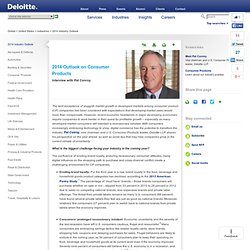
However, recent economic headwinds in major developing economies require companies to work harder in their quest for profitable growth – especially as many developed-market consumers still maintain a recessionary mindset. With consumers increasingly embracing technology to shop, digital commerce has the potential to transform the industry. Pat Conroy, vice chairman and U.S. Consumer Products leader, Deloitte LLP, shares his perspective on the year ahead, as well as some tips that may help companies grow in the current climate of uncertainty. What is the biggest challenge facing your industry in the coming year? What trends might disrupt “business as usual” in 2014?
Disrupting trends include: The Ultimate Guide to Multilingual and Multiregional SEO. International SEO Part Two - YouMoz. Internationalized Domains and SEO - YouMoz. When it comes to international SEO (especially within EU) there are many questions and myths.
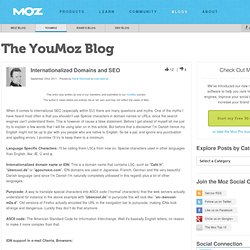
One of the myths I have heard most often is that you shouldn't use Special characters in domain names or URLs, since the search engines can't understand them. This is however of cause a false statement. Before I get ahead of myself let me just try to explain a few words that I will be using later on in this article. But before that a disclaimer I'm Danish hence my English might not be up to par with you people who are native to English. So be a pal, and ignore any punctuation and spelling errors. Language Specific Characters: I'll be calling them LSCs from now on.
Internationalized domain name or IDN: This is a domain name that contains LSC, such as "Café.fr", "übercool.de" or "φρουτακια.com". International SEO & The Future of your ROI at #MozCon by @aleyda. 40+ Tools to Advance Your International SEO Process. The author's posts are entirely his or her own (excluding the unlikely event of hypnosis) and may not always reflect the views of Moz.
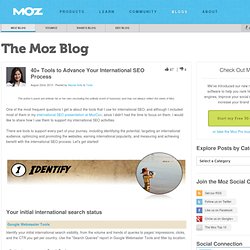
One of the most frequent questions I get is about the tools that I use for international SEO, and although I included most of them in my international SEO presentation at MozCon, since I didn't had the time to focus on them, I would like to share how I use them to support my international SEO activities. There are tools to support every part of your journey, including identifying the potential, targeting an international audience, optimizing and promoting the websites, earning international popularity, and measuring and achieving benefit with the international SEO process.
Let's get started! Your initial international search status Identify your initial international search visibility, from the volume and trends of queries to pages' impressions, clicks, and the CTR you get per country. International SEO: Where to Host and How to Target - Whiteboard Friday. International SEO is big business, and big business equals big websites.

It can be really confusing when you have to cater to a target audience that is the entire world: you know that people from different countries and cultures are going to be looking for different things. We've had a lot of PRO members' Q&A questions come in about this issue lately, so this week, Rand helps us figure out how to deal! He'll show us the pros and cons of using subdomains, subdirectories, and ccTLDs to organize a site's infrastructure and handle different content for different audiences/countries/pandas/orangutans.
Howdy, SEOmoz fans. International SEO: Dropping the Information Dust. The author's posts are entirely his or her own (excluding the unlikely event of hypnosis) and may not always reflect the views of Moz.
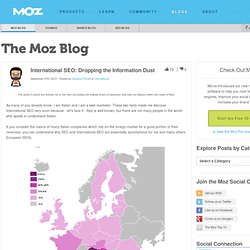
As many of you already know, I am Italian and I am a web marketer. These two facts made me discover International SEO very soon because - let's face it - Italy is well-known, but there are not many people in the world who speak or understand Italian. If you consider the nature of many Italian companies which rely on the foreign market for a good portion of their revenues, you can understand why SEO and International SEO are essentially synonymous for me and many others European SEOs. This map explains why I must be an International SEO. Image by: This explains my interest in how search engines treat the problems associated with multi-country and multi-lingual sites.
Many small and medium-sized businesses now have the desire to engage in a globalized market. The International SEO Checklist. The author's posts are entirely his or her own (excluding the unlikely event of hypnosis) and may not always reflect the views of Moz.
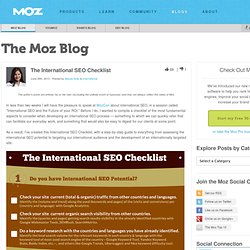
In less than two weeks I will have the pleasure to speak at MozCon about international SEO, in a session called "International SEO and the Future of your ROI. " Before I do, I wanted to compile a checklist of the most fundamental aspects to consider when developing an international SEO process — something to which we can quickly refer that can facilitate our everyday work, and something that would also be easy to digest for our clients at some point. As a result, I've created this International SEO Checklist, with a step-by-step guide to everything from assessing the international SEO potential to targeting our international audience and the development of an internationally targeted site: I've also uploaded a higher resolution version of the checklist image, in case you want to download and print it.
Yikes, looks like something went wrong.